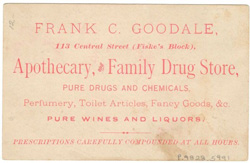Introduction
Nineteenth-Century Pharmacists’ Trade Cards
from the William H. Helfand Collection
Nineteenth-century trade cards can trace their roots to cards used by trades people especially in British cities in the late 17th and early 18th centuries. These cards – printed by engraving, woodblock, or letterpress – depicted storefronts or shop signs and made shops recognizable to customers at a time when there were no street addresses. The concept of the trade card traveled with the printers and trades people as they came to the colonies from England.

A nineteenth century trade card showing an earlier style of illustration and printing.

Advances in printing technology eventually led to the development of color lithography, which allowed trade cards to be printed in full color with a level of photographic realism unrivalled by other printing methods. Trade cards became a visually attractive and affordable form of advertising. Printers offered cards in a variety of sizes and shapes. Potential advertisers could choose stock images as illustrations, or unique designs could be developed for an additional cost. The subject matter on the cards moved beyond simply depicting shop exteriors or signs and began featuring creative interpretations of products as well as a variety of scenes and decorative motifs. As the preparation and distribution of medical drugs became a more and more lucrative business, trade cards served as an important way for pharmacy owners to differentiate themselves from their competitors.

An example of the same trade card "stock" image used by two different pharmacists.

Cards (above and below) showing the prices for printing.

Cards (below) were cut into various shapes as well as the standard rectangle.

One series of cards (below) offered by H.C. Goodwin's New Drug Store. The originals measure approximately one inch by one inch.

Trade cards reached their peak of popularity in the 1880s. They lost their dominance as an advertising medium by the early 20th century, when developments in printing improved the quality and reduced the cost of magazine and newspaper advertising. Over the last fifty years, William H. Helfand amassed a collection of medical and pharmaceutical material that he has generously given to the Library Company. The Helfand Collection provides insight into advertising practices and also serves as a lens through which to consider other aspects of American history including the history of pharmacy and medicine, the growth of industry and commerce, the details of day-to-day life, and historical perceptions of “the other.”

This exhibition was prepared by Cheryl Klimaszewski
Drexel University Intern






















